Exploring the Impact of Facade Color Elements on Visual Comfort in Old Residential Buildings in Shanghai: Insights from Eye-Tracking Technology
Abstract
:1. Introduction
1.1. The Importance of Urban Color
1.2. National Approaches and Territorial Studies
1.3. Limitations of Past Research
1.4. Advantages of Research on Eye-Tracking Technology
1.5. Research Questions and Objectives
- (1)
- To propose a quantitative evaluation method for analyzing the color comfort of building facades using eye movement technology;
- (2)
- To combine color elements, subjective evaluations, and eye-movement indicators to establish a new multifactorial assessment framework for evaluating the color comfort of façades;
- (3)
- To quantitatively analyze the relationship between the three elements of building façade color and visual comfort.
2. Methods
2.1. Research Flow
2.2. Study Area
2.3. Color Selection
2.4. Experimental Equipment
2.5. Subject
2.6. Data Processing and Analysis
3. Results
3.1. Data Processing and Preliminary Explorations
3.2. Influences of Eye Movement, Subjective Evaluation Indicators, and Color Elements
3.2.1. Influence of Pupil Size in Relation to Color Elements
3.2.2. Relationship between the Eye Jump Distance and the Influence of Color Elements
3.2.3. Relationship between the Number of Attention Points and the Influence of Color Elements
3.2.4. Relationship between the Total Gaze Time and the Influence of Color Elements
3.2.5. Visual Comfort in Relation to the Influence of Color Elements
3.2.6. The Relationship between Architectural Color Preferences and the Influence of Color Elements
3.3. Correlation Analysis of Eye Movement and Subjective Evaluation Indicators with Color Elements
3.4. Regression Analysis of Eye Movement and Subjective Evaluation Indicators with Color Saturation and Lightness
4. Discussion
4.1. General Laws and Conclusions
- (1)
- A highly saturated building facade color will significantly reduce the user’s perception of the color of the building to increase the user’s visual fatigue, reducing the user’s evaluation of the building color.
- (2)
- Brightness has a non-linear effect on visual perception, and too much or too little brightness has a bad visual effect on building color. When the brightness is maintained at 60–80%, the user’s perception of the color of the building will be significantly enhanced, increasing the degree of preference for the color of the façade.
- (3)
- Warm colors (red, orange, and yellow) were less irritating to subjects’ eyes and had higher subjective ratings. Among the cooler colors (blue, green, and cyan), subjects had higher eye irritation and lower subjective ratings, but among the cooler colors, subjects rated cyan significantly higher than the other cooler colors. In contrast to cyan, purple was rated significantly lower than the other warm colors, even though it was less irritating to the subjects’ eyes.
4.2. Strengths and Limitations of This Study
5. Conclusions
Author Contributions
Funding
Data Availability Statement
Conflicts of Interest
References
- Jaglarz, A. Perception of Color in Architecture and Urban Space. Buildings 2023, 13, 2000. [Google Scholar] [CrossRef]
- Zhai, Y.; Gong, R.; Huo, J.; Fan, B. Building Façade Color Distribution, Color Harmony and Diversity in Relation to Street Functions: Using Street View Images and Deep Learning. ISPRS Int. J. Geo-Inf. 2023, 12, 224. [Google Scholar] [CrossRef]
- Zhang, L.; Li, X.; Li, C.; Zhang, T. Research on Visual Comfort of Color Environment Based on the Eye-Tracking Method in Subway Space. J. Build. Eng. 2022, 59, 105138. [Google Scholar] [CrossRef]
- Zhong, T.; Ye, C.; Wang, Z.; Tang, G.; Zhang, W.; Ye, Y. City-Scale Mapping of Urban Façade Color Using Street-View Imagery. Remote Sens. 2021, 13, 1591. [Google Scholar] [CrossRef]
- Manav, B. Color-emotion Associations, Designing Color Schemes for Urban Environment-architectural Settings. Color Res. Appl. 2017, 42, 631–640. [Google Scholar] [CrossRef]
- Xu, Z.; Zheng, X. Roadmap of Moving Urban Colour toward Cultural Sustainability in China. Color Res. Appl. 2021, 46, 222–239. [Google Scholar] [CrossRef]
- Odetti, J.V. The Study of Color as a Component of Urban Cultural Construction: A Theoretical Reflection and Methodological Proposal. Color Res. Appl. 2023, 48, 453–467. [Google Scholar] [CrossRef]
- Liu, S.; Zhu, S.Y. Research on Influencing Factors of Urban Color—Taking Changsha as an Example. AMM 2014, 675–677, 1279–1282. [Google Scholar] [CrossRef]
- Li, R.; Wu, M. Revealing Urban Color Patterns via Drone Aerial Photography—A Case Study in Urban Hangzhou, China. Buildings 2024, 14, 546. [Google Scholar] [CrossRef]
- Wang, J.; Zhang, L.; Gou, A. Study of the Color Characteristics of Residential Buildings in Shanghai. Color Res. Appl. 2021, 46, 240–257. [Google Scholar] [CrossRef]
- Guo, H.Y.; Cai, Y.N. China’s Urban Architecture and Environmental Color Practicein in Ten Years. AMM 2012, 174–177, 2512–2515. [Google Scholar] [CrossRef]
- Guo, H.Y.; Cai, Y.N. Urban Color Composition Characteristic in Guangzhou City. AMM 2012, 174–177, 2508–2511. [Google Scholar] [CrossRef]
- Li, Y. Research on the Urban Architecture Color and Chromatography—A Proposal of Digital Environmental Color Taking Dandong City’s Building Color as an Example. AMR 2013, 671–674, 2245–2249. [Google Scholar] [CrossRef]
- Liu, S.; Li, G.Y. Color a City—The Study of Yichang’s Urban Color. AMM 2014, 675–677, 1271–1274. [Google Scholar] [CrossRef]
- Miao, M.; Feng, L.; Wu, Y.; Zhu, R.; Xu, D. Color Authenticity for the Sustainable Development of Historical Areas: A Case Study of Shiquan. Sustainability 2024, 16, 2417. [Google Scholar] [CrossRef]
- Ren, J. Research on Urban Color Environment Planning Based on Regional Characteristics—Take Urban Color Environment of Zhengzhou for Example. AMR 2011, 255–260, 1546–1550. [Google Scholar] [CrossRef]
- Zhang, S.; Liu, Y.; Nie, H. Geographical Feature Based Research on Urban Color Environment—Taking Wuhan as an Example. IERI Procedia 2014, 9, 190–195. [Google Scholar] [CrossRef]
- Gou, A.; Wang, J. Research on the Location Characters of Urban Color Plan in China. Color Res. Appl. 2008, 33, 68–76. [Google Scholar] [CrossRef]
- Wang, J.; Zhang, L.; Gou, A. Study on the Preference of City Color Image Selection Based on the Logistic Model: A Case Study of Shanghai. Color Res. Appl. 2020, 45, 542–557. [Google Scholar] [CrossRef]
- Chen, K.; Lin, H.; Chen, Y.-J.; Xu, Y.; Ding, S.; Guo, Y.; You, S. Do Consumers Have Colour Aesthetic Preferences for the Facade Materials of Condominium Buildings? Buildings 2024, 14, 557. [Google Scholar] [CrossRef]
- Wang, Z.; Sun, H.; Li, J. Research on Architectural Color and Visual Comfort in Historic Landscape Areas. Buildings 2023, 13, 1004. [Google Scholar] [CrossRef]
- Xu, Z.; Zhang, F.; Wang, H.; Gao, Y.; Xu, M.; Ran, J.; Wang, M.; Xia, J. Deep Learning Based Urban-Building Color Obtaining Method, Involves Picking up, Summarizing and Counting Color of Extracted Building, and Performing Color Clustering to Obtain Main Color of Building in Different Areas. Patent CN110197511-A, 2019. Available online: https://webofscience.clarivate.cn/wos/alldb/full-record/DIIDW:201978988F (accessed on 10 May 2024).
- Kong, L.; Liu, J.; Qiao, C.; Wang, W.; Xu, N.; Ren, Y.; Xu, X. Dividing Urban Color Grade, Involves Constructing Evaluation System of City Space Color by Analytic Hierarchy Process of Factors Influencing City Color, and Generating Element Data Set of Sub-Standard Layer. Patent CN113610295-A, 2021. Available online: https://webofscience.clarivate.cn/wos/alldb/full-record/DIIDW:2021C90961 (accessed on 10 May 2024).
- Ou, L.; Luo, M.R. A Colour Harmony Model for Two-colour Combinations. Color Res. Appl. 2006, 31, 191–204. [Google Scholar] [CrossRef]
- Zhao, J.; Yan, Y.; Deng, H.; Liu, G.; Dai, L.; Tang, L.; Shi, L.; Shao, G. Remarks about Landsenses Ecology and Ecosystem Services. Int. J. Sustain. Dev. World Ecol. 2020, 27, 196–201. [Google Scholar] [CrossRef]
- Duchowski, A.T. A Breadth-First Survey of Eye-Tracking Applications. Behav. Res. Methods Instrum. Comput. 2002, 34, 455–470. [Google Scholar] [CrossRef] [PubMed]
- Rayner, K. Eye Movements in Reading and Information Processing: 20 Years of Research. Eye Mov. Read. 1998, 124, 372–422. [Google Scholar] [CrossRef] [PubMed]
- Tatler, B.W. The Central Fixation Bias in Scene Viewing: Selecting an Optimal Viewing Position Independently of Motor Biases and Image Feature Distributions. J. Vis. 2007, 7, 4. [Google Scholar] [CrossRef] [PubMed]
- De Lucio, J.V.; Mohamadian, M.; Ruiz, J.P.; Banayas, J.; Bernaldez, F.G. Visual Landscape Exploration as Revealed by Eye Movement Tracking. Landsc. Urban Plan. 1996, 34, 135–142. [Google Scholar] [CrossRef]
- Hasse, C.; Weber, R. Eye Movements on Facades: The Subjective Perception of Balance in Architecture and Its Link to Aesthetic Judgment. Empir. Stud. Arts 2012, 30, 7–22. [Google Scholar] [CrossRef]
- Li, Z.; Sun, X.; Zhao, S.; Zuo, H. Integrating Eye-Movement Analysis and the Semantic Differential Method to Analyze the Visual Effect of a Traditional Commercial Block in Hefei, China. Front. Archit. Res. 2021, 10, 317–331. [Google Scholar] [CrossRef]
- Szekely, D.; Vert, S.; Rotaru, O.; Andone, D. Usability Evaluation with Eye Tracking: The Case of a Mobile Augmented Reality Application with Historical Images for Urban Cultural Heritage. Heritage 2023, 6, 3256–3270. [Google Scholar] [CrossRef]
- Williams, P.C. The Effect of Surface Colour on Apparent Surface Distance. Light. Res. Technol. 1972, 4, 27–30. [Google Scholar] [CrossRef]
- Li, N.; Zhang, S.; Xia, L.; Wu, Y. Investigating the Visual Behavior Characteristics of Architectural Heritage Using Eye-Tracking. Buildings 2022, 12, 1058. [Google Scholar] [CrossRef]
- Lv, J.; Xu, X.; Ding, N. Research on the Quantitative Method of Cognitive Loading in a Virtual Reality System. Information 2019, 10, 170. [Google Scholar] [CrossRef]
- Yamamoto, N.; Philbeck, J.W. Peripheral Vision Benefits Spatial Learning by Guiding Eye Movements. Mem. Cogn. 2013, 41, 109–121. [Google Scholar] [CrossRef] [PubMed]
- Kiefer, P.; Giannopoulos, I.; Raubal, M.; Duchowski, A. Eye Tracking for Spatial Research: Cognition, Computation, Challenges. Spat. Cogn. Comput. 2017, 17, 1–19. [Google Scholar] [CrossRef]
- Babiker, A.; Faye, I.; Prehn, K.; Malik, A. Machine Learning to Differentiate Between Positive and Negative Emotions Using Pupil Diameter. Front. Psychol. 2015, 6, 1921. [Google Scholar] [CrossRef]
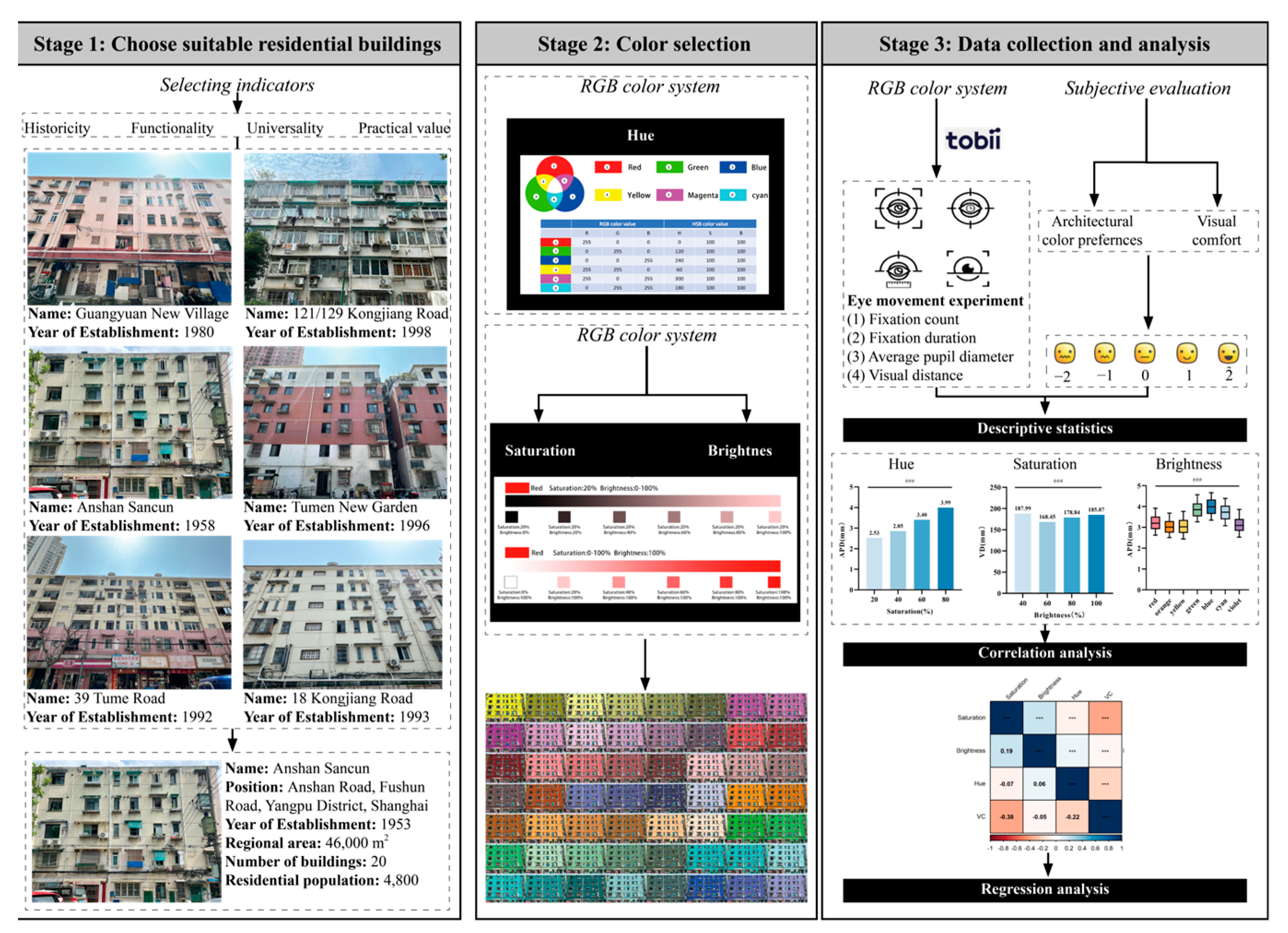
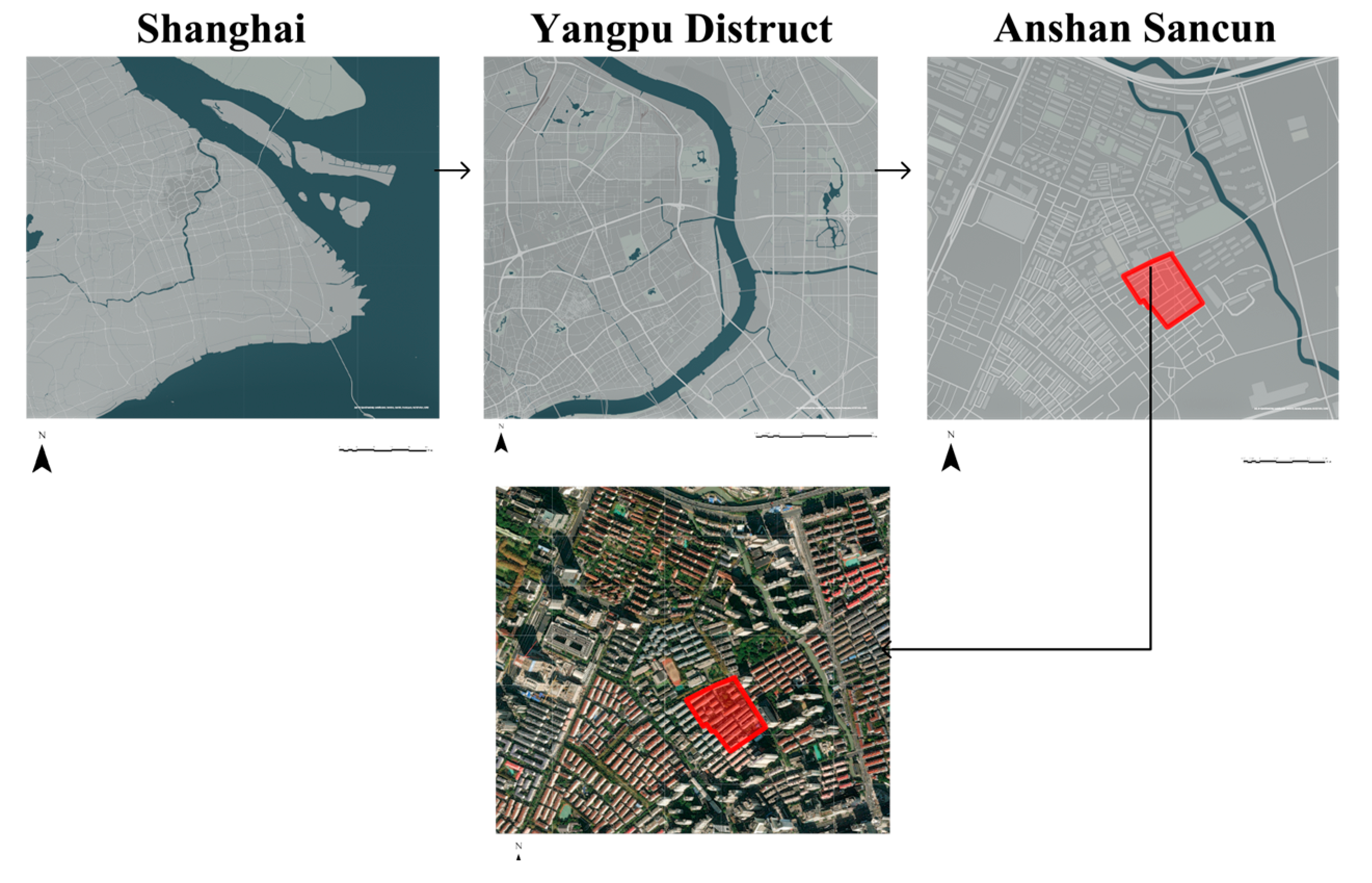
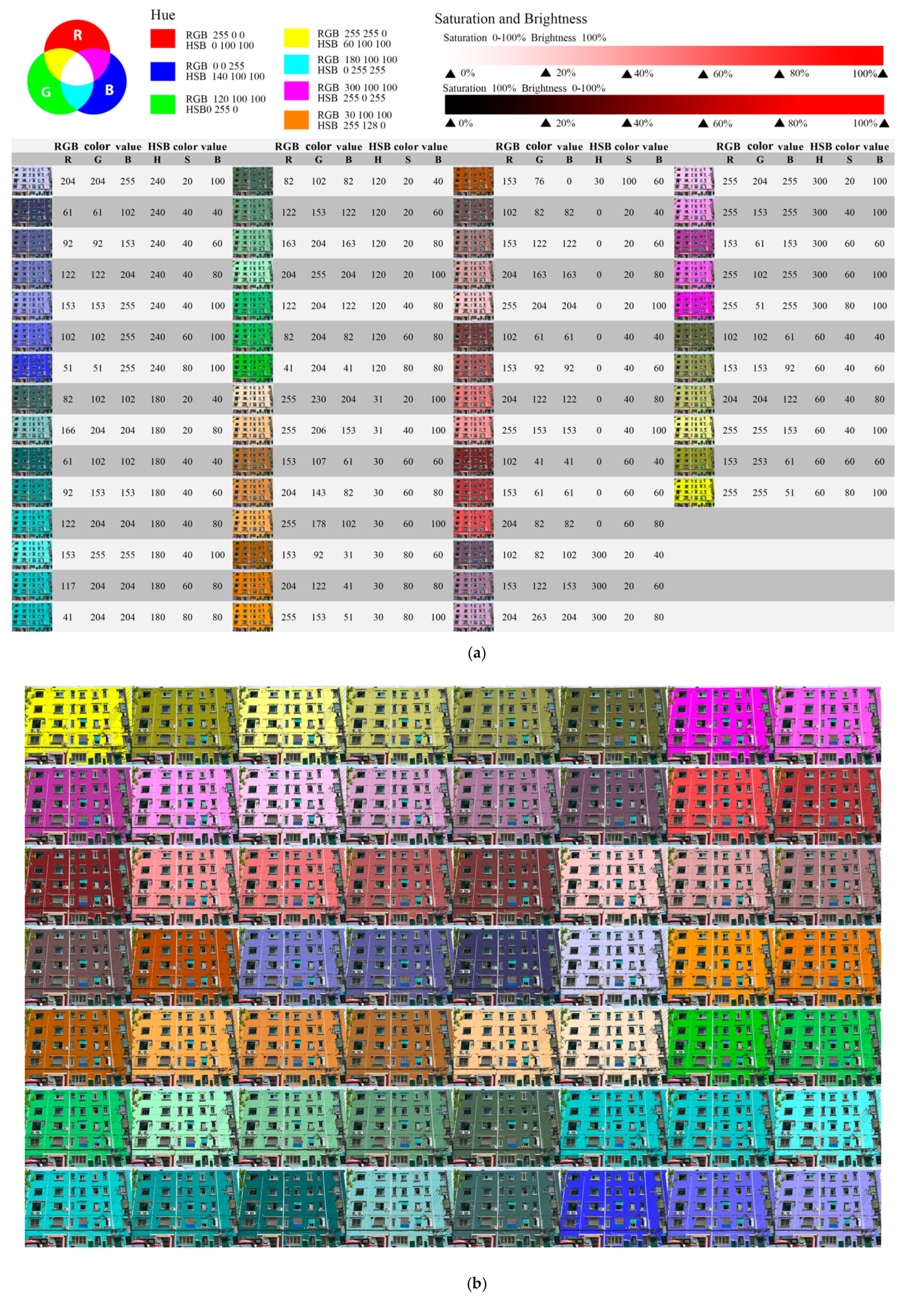
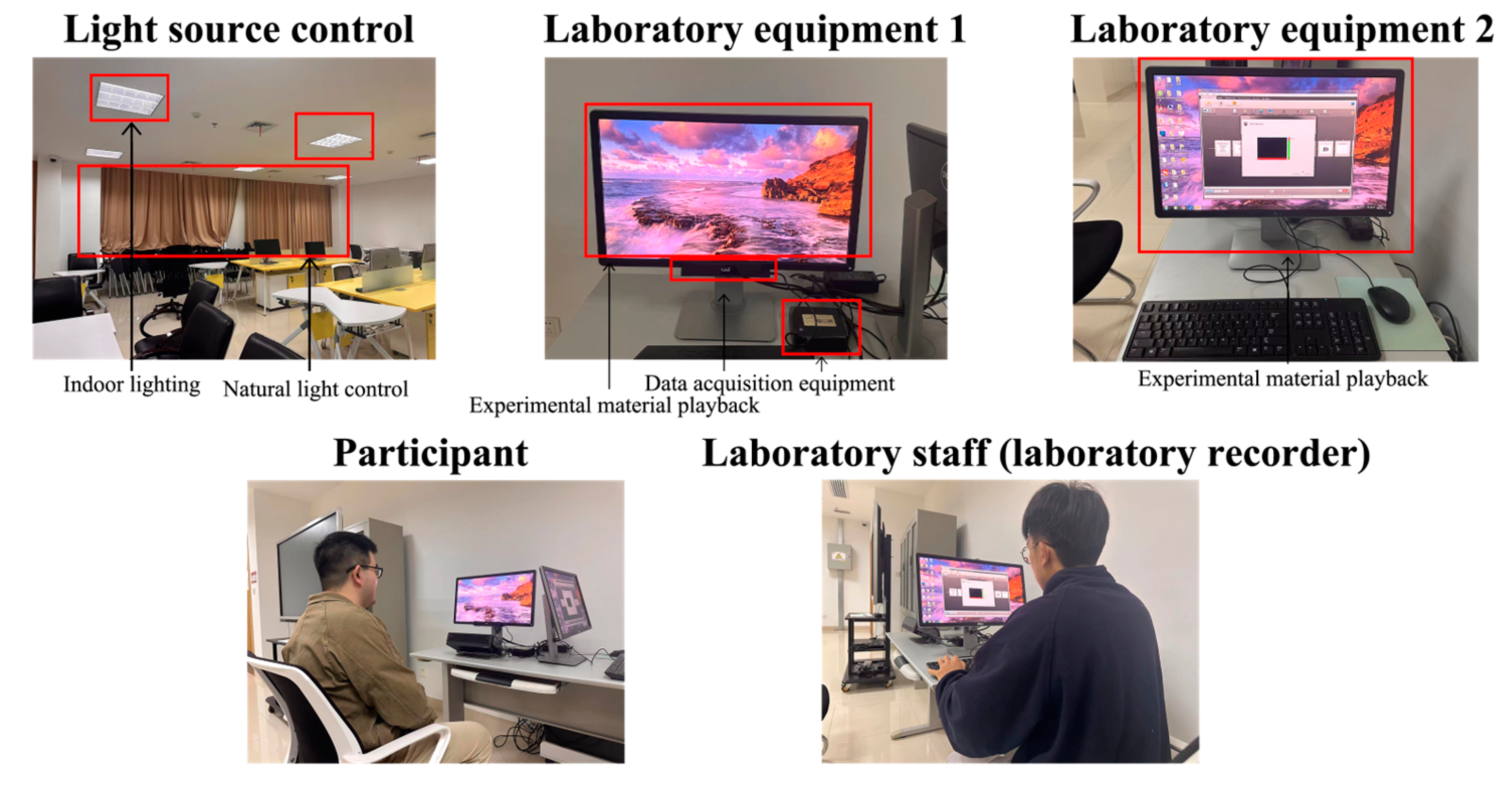
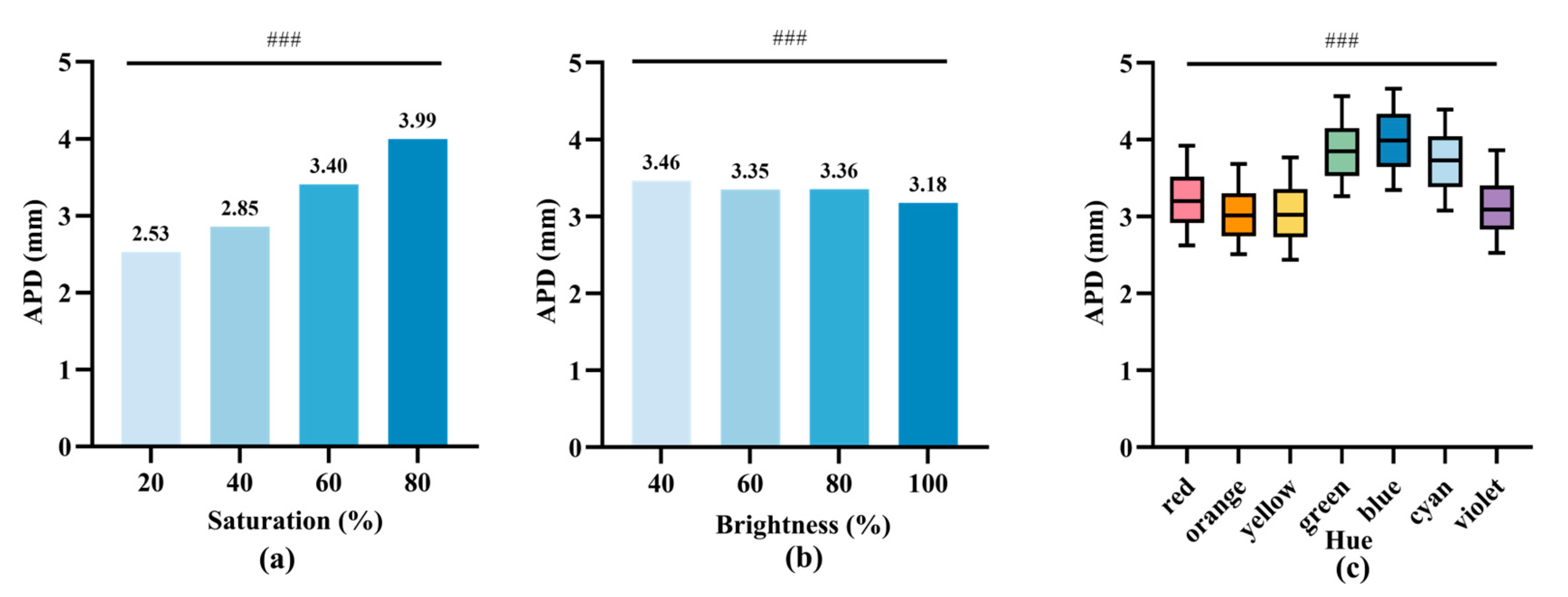

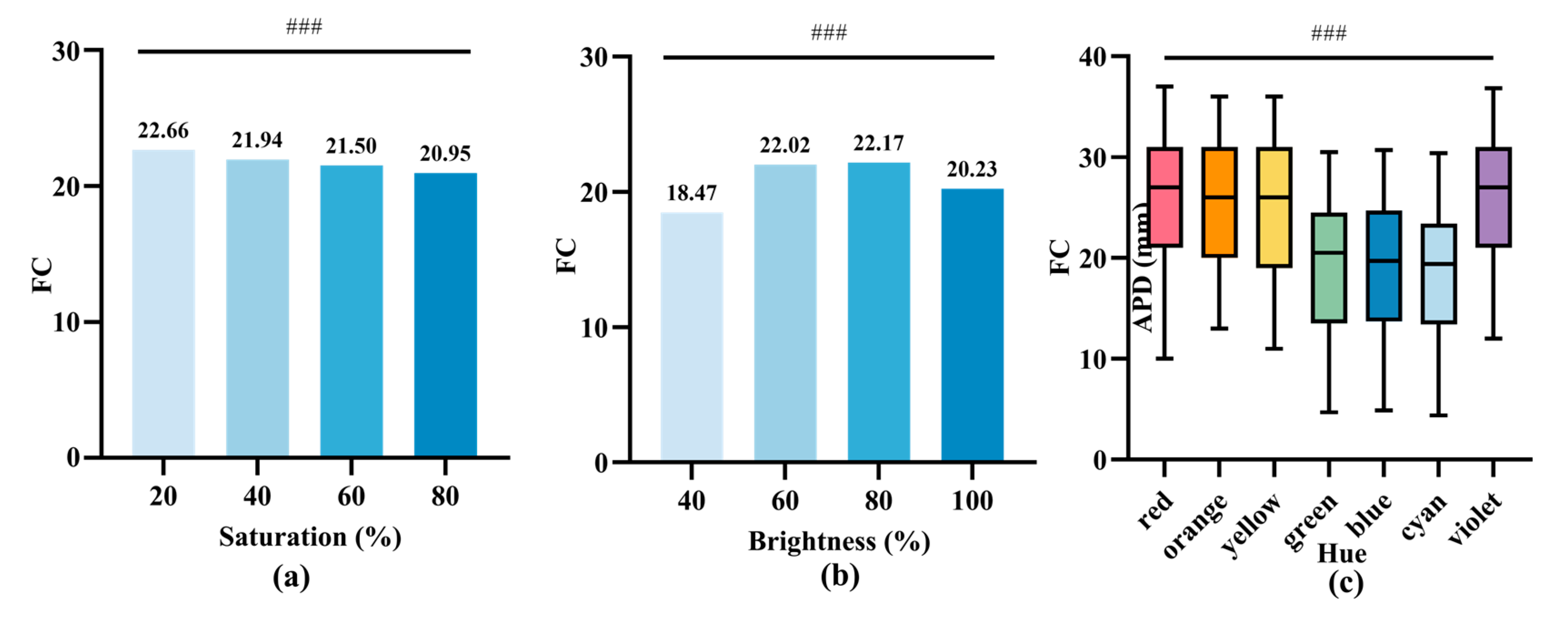



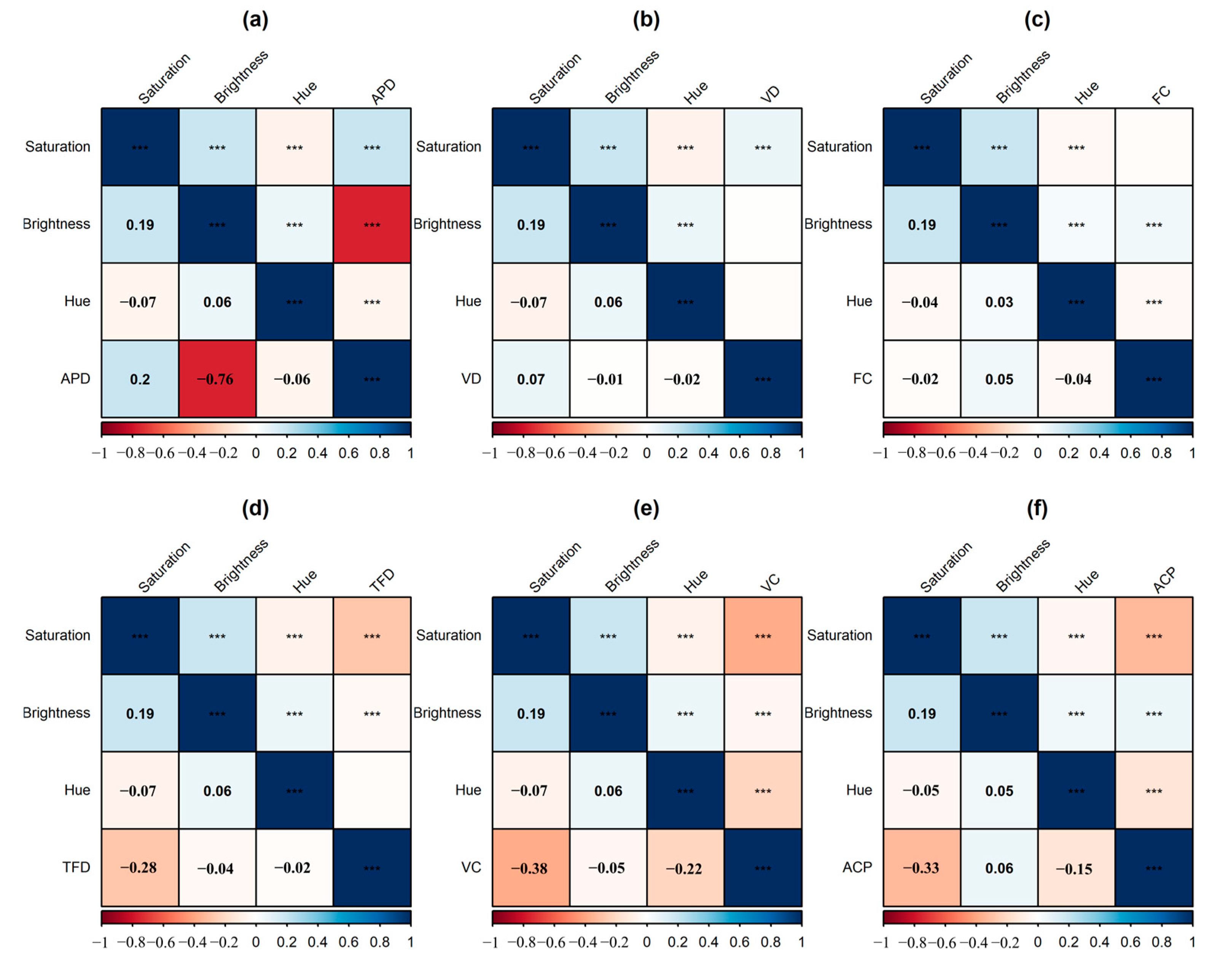
| Name | Abbreviation | Meaning |
|---|---|---|
| Visual distance | VD | Visual distance is the sum of the distances between gaze points. When visual fatigue occurs, the eyeballs will perform subconscious sweeping activities to relieve fatigue, which can reflect the degree of stimulation of the picture for the observer. |
| Average pupil diameter | APD | Pupil diameter is a characterization of the size of the pupil; the larger the pupil diameter, indicating the amount of incoming light, the larger the cognitive load, which can directly reflect the emotions at the time of viewing. |
| Total fixation duration | TFD | Total fixation is the duration of all gaze points within that AOI, reflecting the preference for the stimulus object. |
| Fixation count | FC | Fixation count indicates the cognitive processing of the image by the viewer and can reflect the level of interest in the visual object. |
| Evaluation Indicators | Abridge | Subjective Rating | ||||
|---|---|---|---|---|---|---|
| Architectural Color Preferences | ACP | −2 | −1 | 0 | 1 | 2 |
| Visual Comfort | VC | −2 | −1 | 0 | 1 | 2 |
| Evaluation Indicators | p Values | ||
|---|---|---|---|
| Saturation | Brightness | Hue | |
| APD | <0.001 | <0.001 | <0.001 |
| VD | <0.001 | <0.001 | <0.001 |
| FC | 0.0019 | <0.001 | <0.001 |
| TFD | <0.001 | <0.001 | <0.001 |
| Evaluation Indicators | Saturation | Brightness | Saturation and Brightness | |||
|---|---|---|---|---|---|---|
| Mathematical Model | R2 | Mathematical Model | R2 | Mathematical Model | R2 | |
| APD | 0.73S + 2.97 | 0.87 *** | −2.59B + 5.28 | 0.91 *** | 1.29S − 2.82B + 4.89 | 0.92 *** |
| VD | 22.96S + 168.33 | 0.83 *** | 102.24B2 − 151.19B + 229.29 | 0.84 *** | 120.66B2 − 182.64B + 27.59S + 229.65 | 0.86 *** |
| FC | −0.67S + 20.86 | 0.65*** | −34.23B2 + 50.89B + 3.33 | 0.81 *** | −35.01B2 + 52.31B − 1.67S + 3.46 | 0.75 *** |
| TFD | −3.00S + 5.82 | 0.76 *** | −6.13B2 + 8.40B + 1.97 | 0.83 *** | −8.27B2 + 12.07B − 3.23S + 1.93 | 0.85 *** |
| VC | −2.20S + 0.14 | 0.73 *** | −14.80B2 + 14.38B − 16.39 | 0.77 *** | −10.09B2 + 14.72B − 2.48S − 4.62 | 0.79 *** |
| ACP | −1.84S + 7.27 | 0.79 *** | 0.33B − 0.71 | 0.80 *** | 0.69B − 1.98S − 0.11 | 0.81 *** |
Disclaimer/Publisher’s Note: The statements, opinions and data contained in all publications are solely those of the individual author(s) and contributor(s) and not of MDPI and/or the editor(s). MDPI and/or the editor(s) disclaim responsibility for any injury to people or property resulting from any ideas, methods, instructions or products referred to in the content. |
© 2024 by the authors. Licensee MDPI, Basel, Switzerland. This article is an open access article distributed under the terms and conditions of the Creative Commons Attribution (CC BY) license (https://creativecommons.org/licenses/by/4.0/).
Share and Cite
Wang, Z.; Shen, M.; Huang, Y. Exploring the Impact of Facade Color Elements on Visual Comfort in Old Residential Buildings in Shanghai: Insights from Eye-Tracking Technology. Buildings 2024, 14, 1758. https://doi.org/10.3390/buildings14061758
Wang Z, Shen M, Huang Y. Exploring the Impact of Facade Color Elements on Visual Comfort in Old Residential Buildings in Shanghai: Insights from Eye-Tracking Technology. Buildings. 2024; 14(6):1758. https://doi.org/10.3390/buildings14061758
Chicago/Turabian StyleWang, Zhanzhu, Maoting Shen, and Yongming Huang. 2024. "Exploring the Impact of Facade Color Elements on Visual Comfort in Old Residential Buildings in Shanghai: Insights from Eye-Tracking Technology" Buildings 14, no. 6: 1758. https://doi.org/10.3390/buildings14061758
APA StyleWang, Z., Shen, M., & Huang, Y. (2024). Exploring the Impact of Facade Color Elements on Visual Comfort in Old Residential Buildings in Shanghai: Insights from Eye-Tracking Technology. Buildings, 14(6), 1758. https://doi.org/10.3390/buildings14061758






